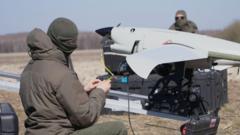At a discreet facility shrouded from public scrutiny, Ukrainian engineers are diligently testing the capabilities of a long-range drone dubbed Raybird. This drone, resembling a compact aircraft with extended wings, is propelled from a launchpad akin to an arrow shot from a bow, demonstrating remarkable endurance by flying continuously for over 20 hours and covering distances exceeding 1,000km (approximately 620 miles). The drone's primary objectives include striking targets crucial to Russia's war efforts, such as oil refineries and fuel depots.
Recent diplomatic developments have introduced a complex layer to Ukraine's military strategies. Following agreements brokered with the United States on a partial ceasefire, Russia and Ukraine agreed to refrain from assaulting each other's energy resources. Additionally, a maritime ceasefire was established in the Black Sea after discussions held in Saudi Arabia. Ukrainian President Volodymyr Zelensky announced immediate compliance with these agreements. However, skepticism abounds, particularly among Ukrainian engineers like Oleksiy from Skyeton, the firm responsible for the Raybird's development. He expressed doubts about Russia’s commitment to the ceasefire, suggesting that agreements often come after aggressive acts.
This new ceasefire could provide some reprieve for Russia, which has faced significant losses; Ukrainian drone operations have led to over 30 attacks on Russian oil infrastructures this year, contributing to a noticeable decline of approximately 10% in Russia’s oil refining capabilities, according to reports. Moscow's protracted ban on petroleum exports further indicates the economic toll it has experienced.
Furthermore, Ukrainian advancements in drone technology are accelerating. Zelensky highlighted the emergence of new drones capable of reaching targets as far as 3,000 km (around 1,860 miles), potentially threatening areas deep within Russia, including Siberia. This escalation includes turbojet-powered missile-drones that increase the speed and difficulty of interception. Reports hint that Ukraine has recently tested an upgraded version of the Neptune cruise missile, although officials are reticent to confirm the details regarding an attack on a Russian airbase.
The ceasefire agreement also serves to mitigate some pressures on Ukraine as it has faced relentless assaults on its own power plants and energy infrastructure, causing energy generation capacity to plummet significantly. Russian drone attacks last winter left substantial portions of the population without heat and electricity, as ongoing assaults target gas storage and production facilities crucial for Ukraine's energy security.
Despite the easing of direct aggression envisioned by the ceasefire, Oleksiy remains resolute in his commitment to advancing drone technology. He acknowledges the necessity of preparedness, stating, “Our enemy just wants to have a break, gather its strength and attack again.” This underscores a prevailing sentiment among Ukrainian engineers that continued innovation and development of military capabilities remain critical amidst the uncertainty of future confrontations.



















